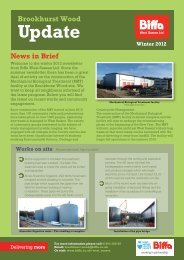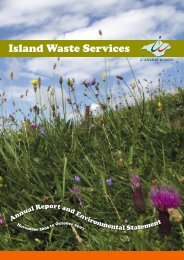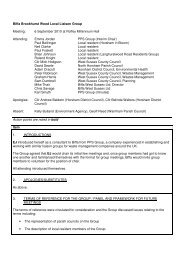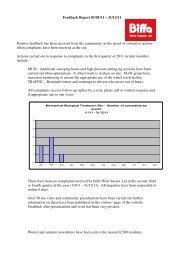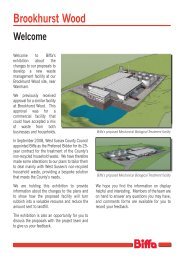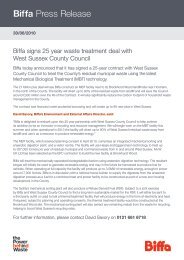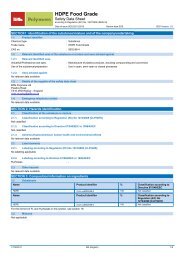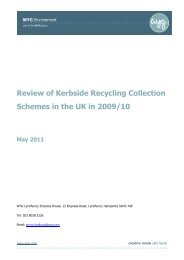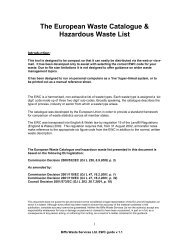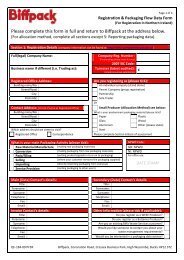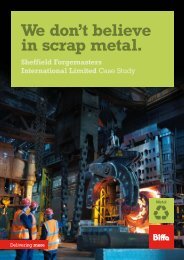detailed explanation for each SIC code - Biffa
detailed explanation for each SIC code - Biffa
detailed explanation for each SIC code - Biffa
Create successful ePaper yourself
Turn your PDF publications into a flip-book with our unique Google optimized e-Paper software.
Explanatory Notes<br />
UK Standard Industrial Classification of Economic Activities 2007 – <strong>SIC</strong>(2007)<br />
38.11 Collection of non-hazardous waste<br />
This class includes:<br />
–<br />
–<br />
–<br />
collection of non-hazardous solid waste (i.e. garbage) within a local area, such as collection of waste, which may include<br />
mixed recoverable materials, from households and businesses by means of refuse bins, wheeled bins, containers etc.<br />
collection of recyclable materials<br />
collection of refuse in litter-bins in public places<br />
This class also includes:<br />
E<br />
–<br />
–<br />
–<br />
–<br />
collection of construction and demolition waste<br />
collection and removal of debris such as brush and rubble<br />
collection of waste output of textile mills<br />
operation of waste transfer facilities <strong>for</strong> non-hazardous waste<br />
This class excludes:<br />
–<br />
–<br />
–<br />
collection of hazardous waste, see 38.12<br />
operation of landfills <strong>for</strong> the disposal of non-hazardous waste, see 38.21<br />
operation of facilities where mixed recoverable materials such as paper, plastics, etc. are sorted into distinct categories,<br />
see 38.32<br />
38.12 Collection of hazardous waste<br />
This class includes the collection of solid and non-solid hazardous waste, i.e. explosive, oxidising, flammable, toxic, irritant,<br />
carcinogenic, corrosive, infectious or other substances and preparations harmful to human health and the environment. It may<br />
also entail identification, treatment, packaging and labelling of waste <strong>for</strong> the purposes of transport.<br />
This class includes:<br />
–<br />
–<br />
collection of hazardous waste, such as:<br />
■ used oil from shipment or garages<br />
■ bio-hazardous waste<br />
■ nuclear waste<br />
■ used batteries etc.<br />
operation of waste transfer stations <strong>for</strong> hazardous waste<br />
This class excludes:<br />
–<br />
remediation and clean up of contaminated buildings, mine sites, soil, ground water, e.g. asbestos removal, see 39.00<br />
38.2 Waste treatment and disposal<br />
This group includes the disposal and treatment prior to disposal of various <strong>for</strong>ms of waste by different means, such as treatment<br />
of organic waste with the aim of disposal; treatment and disposal of toxic live or dead animals and other contaminated waste;<br />
treatment and disposal of transition radioactive waste from hospitals, etc.; dumping of refuse on land or in water; burial or<br />
ploughing-under of refuse; disposal of used goods such as refrigerators to eliminate harmful waste; disposal of waste by<br />
incineration or combustion. Energy recovery resulting from waste incineration processes is also included.<br />
This group excludes:<br />
–<br />
–<br />
treatment and disposal of waste water (see class 37.00).<br />
materials recovery, see 38.3<br />
38.21 Treatment and disposal of non-hazardous waste<br />
This class includes the disposal and treatment prior to disposal of solid or non-solid non-hazardous waste:<br />
–<br />
–<br />
–<br />
operation of landfills <strong>for</strong> the disposal of non-hazardous waste<br />
disposal of non-hazardous waste by combustion or incineration or other methods, with or without the resulting production<br />
of electricity or steam, compost, substitute fuels, biogas, ashes or other by-products <strong>for</strong> further use etc.<br />
treatment of organic waste <strong>for</strong> disposal<br />
This class excludes:<br />
–<br />
–<br />
–<br />
incineration and combustion of hazardous waste, see 38.22<br />
operation of facilities where mixed recoverable materials such as paper, plastics, used beverage cans and metals are sorted<br />
into distinct categories, see 38.32<br />
decontamination, clean up of land, water; toxic material abatement, see 39.00<br />
38.22 Treatment and disposal of hazardous waste<br />
This class includes the disposal and treatment prior to disposal of solid or non-solid hazardous waste, including waste that is<br />
explosive, oxidising, flammable, toxic, irritant, carcinogenic, corrosive, infectious and other substances and preparations harmful<br />
to human health and the environment.<br />
146



